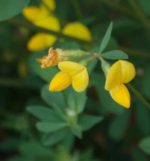
This herbaceous perennial, also known as eggs and bacon and birdsfoot deervetch, is native to the grasslands of Eurasia and North Africa. It was introduced to the US from Europe by chance and was subsequently cultivated for forage and erosion control along highways. Now it is found in moist, open areas such as pastures, meadows, riverbanks, roadsides and waste areas throughout North America except the Deep South. It forms dense mats that shade out the native vegetation and is especially troublesome in the prairies and grasslands of the Midwest. Like other members of the pea family, it fixes nitrogen in the soil and is highly nutritious to cattle without causing bloating, so continues to be cultivated. Prefers full sun and moist soil but tolerates dry, droughty soil. USDA Hardiness Zones 3-8
Description: Plants grow up to 2′ tall from a long taproot with branched underground roots and above ground stolons and rhizomes. They have well-branched stems and alternate compound leaves with 3 leaftlets about .5″ long, the central 3 of which extend above the others giving rise to the trefoil part of the common name. From spring until mid summer, rounded clusters of 2-8 bright yellow to orange flowers appear. Each pea-like flower is up to 2/3″ long and has petals sometimes streaked with red. The brown cylindrical seed pods are 1/4-1 3/4″ long, contain numerous seeds, and look like bird’s toes giving rise to the common name bird’s foot trefoil/deervetch. Plants spread by seed, stolons and rhizomes.
Control: Plants are difficult to control because even a fragment of root will give rise to a new plant. Small infestations can be removed by digging with care being taken to get every piece of the roots, rhizomes and stolons. Close mowing below 2″ for several years will cut seed production and spread by rhizomes or stolons and reduce the overall number of plants but may hurt the native vegetation. Burning is not recommended because it increases seed germination and results in a bigger population. In severe cases an herbicide containing clopyralid, which is selective to legumes and plants in the aster family, may be needed.